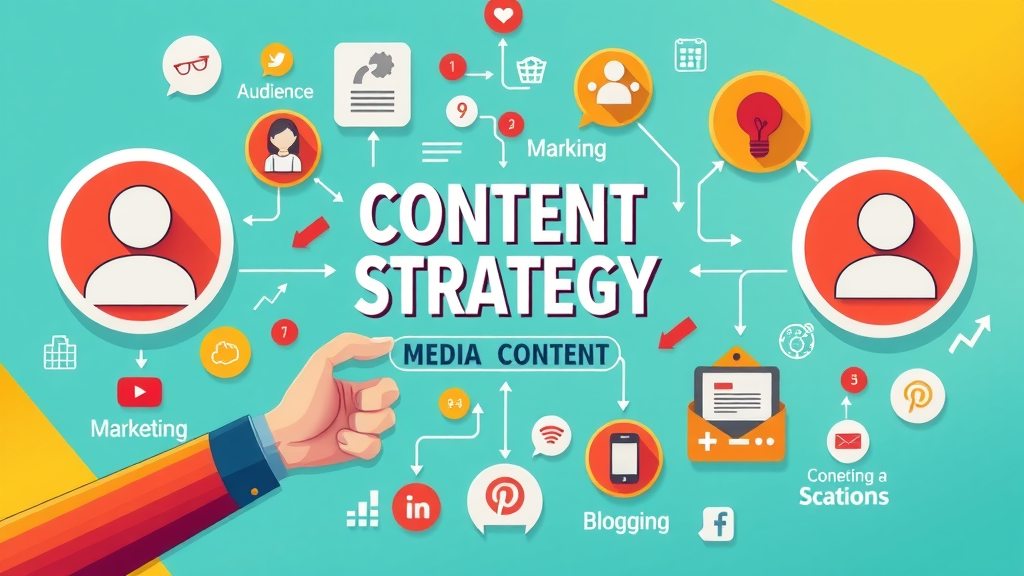Ready to supercharge your brand’s success? Here’s the key insight: Companies with a documented content strategy are 60% more likely to achieve their marketing goals than those without a clear plan. In today’s digital marketing landscape, having a well-crafted content strategy is non-negotiable. Whether you run a global business or a budding startup, understanding how to design, execute, and optimize your content strategy is the most effective way to increase engagement, fuel growth, and outshine your competition. In this comprehensive guide, you’ll uncover actionable steps, essential tools, and expert insights to help you unlock the full potential of your content marketing—and propel your business to new heights.
Did You Know? Businesses With a Documented Content Strategy Are 60% More Likely to Succeed
Statistics reveal that brands leveraging a robust content strategy don’t just gain a competitive edge—they dominate their markets. Social media engagement, brand loyalty, and media content performance all surge when companies plan and document their content initiatives. For example, organizations with an active content plan are better equipped to deliver tailored blog posts and targeted social media content that resonates with their target audience .
Effective content marketing means aligning every piece of content—whether it’s a blog post or a bite-sized video—with larger business goals . In companies where a content team works closely with marketing strategists, efforts are consistently directed toward achieving measurable business goal outcomes. If you’re seeking greater return on investment from your digital market presence, understanding and implementing a robust content strategy is the clear path forward.

"A robust content strategy shifts brands from random acts of publishing to delivering tangible business growth." – Leading Marketing Executive
Understanding the Foundations of a Successful Content Strategy
- The importance of a content strategy in digital marketing
- Essential steps to build an effective content strategy
- How content marketing, content creation, and media content fit together
- Actionable content strategy tips for any team size
Defining Content Strategy: The Cornerstone of Content Marketing
At its core, a content strategy is a comprehensive roadmap for planning, creating, distributing, and managing valuable content types —all tailored to meet specific content goals and audience needs. Unlike ad hoc publishing, strategic content creation ensures every article, video, infographic, or social media asset serves a clear business purpose, such as attracting a potential customer or strengthening your brand voice.
Without a thoughtful content strategy , brands risk producing irrelevant or inconsistent content that doesn’t drive engagement or results. Industry leaders like Kristina Halvorson stress the importance of documenting strategies for systematic success—whether you’re developing long-form resources, bite-sized social media content , or compelling blog posts. By establishing a foundation for content planning, businesses ensure each piece of content delivers measurable impact, aligned with both user intent and search engine requirements.

The Role of Content Strategy in Social Media Success
Today’s top brands harness content strategy to amplify social media presence, increase engagement, and attract new audiences. A defined content strategy provides the roadmap for what, when, and how to publish across platforms such as Instagram, LinkedIn, Twitter, and emerging channels. Successful brands map their social media content to both their overall marketing strategy and platform-specific requirements, ensuring brand consistency and relevance.
By applying analytics to track what types of content perform best, companies refine their approach in real time, consistently outpacing competitors. Knowing your target audience and aligning content with their unique preferences—whether educational articles, infographics, or entertaining videos—sets the foundation for viral campaigns and sustained online growth. A strong content strategy drives your brand’s voice across all touchpoints, supporting both immediate wins and long-term social media leadership.
Why Every Business Needs a Content Strategy for Growth
- Drives targeted engagement
- Supports multichannel success (social media, blogs, media content)
- Powers efficient content management
- Reinforces overall marketing strategy
Every modern business, regardless of size or industry, now competes in a fast-paced digital market where attention is currency. A powerful content strategy is the most effective way to consistently engage your target audience , distinguish your brand, and drive measurable business value. The days of publishing random blog posts or sporadic social media updates are over—today’s high-growth brands plan, execute, and optimize every piece of content for maximum return.
Not only does a documented content strategy power efficient content management , but it also supports broader marketing strategy objectives. From driving more traffic to your website and generating high-quality leads, to building brand trust through expert-driven media content , a unified approach ensures resources are used wisely, and every content piece reinforces your core business goals.
Connecting Content Strategy, Content Marketing, and Media Content
While content strategy , content marketing , and media content are closely linked, each plays a distinct role. Content strategy is the macro-level plan that ensures every content asset supports your business vision. Content marketing uses these assets—like blog posts, guides, and social media content—to achieve specific marketing outcomes, such as increased website visits or lead generation.
Media content , meanwhile, refers to the actual materials created—from written articles and infographics to videos and podcasts. Integrating all three allows brands to create, distribute, and manage types of content that both fulfill business goals and engage customers across channels. The right approach creates a seamless journey for users, guiding them from first touch to loyal fan.

Real-World Example: How Content Strategy Transformed a Brand's Social Media Content
Consider a retail startup that struggled to stand out amid fierce competition. Initially, their social media content lacked direction—posts were sporadic and failed to connect. After implementing a data-driven content strategy, they methodically mapped content types to the interests of each buyer persona . By leveraging an editorial calendar and aligning messaging with key seasonal trends, engagement rates soared by 120% in just six months.
Through continuous content audits and strategic planning, the brand evolved from simply “posting” to orchestrating impactful digital campaigns. This real-world turnaround highlights how a focused content strategy not only fuels online growth but transforms entire businesses by driving both reach and meaningful interactions.
Deconstructing a Winning Content Strategy: From Planning to Execution
- 1. Goal definition
- 2. Audience research
- 3. Content audit
- 4. Editorial calendar development
- 5. Content creation
- 6. Content distribution
- 7. Performance measurement

Aligning Content Strategy With Your Marketing Strategy
Successful brands recognize that content strategy is inseparable from their overarching marketing strategy . Every content plan should be built upon the core objectives that drive your business, such as raising brand awareness, generating leads, or supporting customer retention. It’s essential to clearly define business goals and ensure all team members—from writers to content strategists—align on messaging and priorities.
Integrating content planning with other digital marketing efforts, such as paid ads or influencer partnerships, creates a comprehensive approach that amplifies results across all fronts. Regular collaboration between teams brings cohesion, maintains brand voice, and maximizes return on investment, ultimately giving your content the power to support broader marketing wins.
How Social Media Content Fits Into Your Overall Content Strategy
Social media is no longer just an add-on; it’s a fundamental part of any effective content strategy . Your social media content should be guided by the same research, messaging, and performance metrics as your blog posts or educational resources. This means using insights gathered from target audience research to inform your approach—what platforms your customers use, when they’re most active, and the types of content they engage with most.
Scheduling regular evaluation with analytics tools helps refine your postings, adjust campaign direction, and boost returns from every tweet, post, or story. Treat your social channels as core communication touchpoints—integrated, strategic, and aligned with every aspect of your business mission.
Building a Robust Content Marketing Strategy: Tools and Templates
Equipping your team with proven tools and templates streamlines every stage of the content lifecycle. For planning, free editorial calendar templates and modern project management software keep your schedule—and your team—on track. Analytics platforms provide real-time data on content performance , while style guide templates standardize brand voice.
Investing in collaborative tools not only simplifies content management , but keeps all stakeholders—writers, strategists, designers—in sync. Whether you’re a solo entrepreneur or a multi-person content team, these resources build the infrastructure for scalable, repeatable content marketing success.
| Element | Content Strategy | Content Marketing Strategy | Social Media Strategy |
|---|---|---|---|
| Objectives | Business goals, audience, process | Engagement, leads, brand building | Brand awareness, real-time engagement |
| Channels | All digital & traditional platforms | Website, blogs, emails, video | Facebook, Twitter, LinkedIn, Instagram, TikTok |
| Elements | Planning, creation, governance, metrics | Campaigns, editorial calendar, content offers | Posting calendar, engagement tactics, influencer collabs |
Target Audience and Content Strategy: How to Map Content Types to Your Readers
- Persona development
- Needs assessment
- Content calendar alignment
- Blog post & media content type selection
Understanding your target audience is the bedrock of any successful content strategy . Start by developing detailed buyer persona profiles—fictional representations of your ideal customers, capturing demographics, interests, and digital habits. Once personas are established, conduct a thorough needs assessment to uncover pain points, questions, and desires that your content types should address.
Aligning your content calendar with key audience moments—such as product launches or seasonal trends—guarantees relevance and timeliness. By carefully selecting the right blog posts , videos, or interactive media content, you ensure each piece of content offers real value, guiding prospects along the path to purchase while deepening loyalty among existing customers.

The Vital Role of Content Audit in Updating Your Content Strategy
Performing a regular content audit is an essential step for improving and evolving your content strategy . This process involves cataloging existing content assets—such as blog posts, e-books, and social media updates—and analyzing them for quality, performance, and relevance to current business goals. Through a content audit, you can identify gaps, outdated information, and opportunities for repurposing or enhancing high-performing pieces.
This systematic review keeps your content plan fresh and aligned with changing target audience expectations. Furthermore, audits inform future content creation by revealing what works, what doesn’t, and where your team should focus next, ensuring you remain competitive in the dynamic digital landscape.
Using an Editorial Calendar to Streamline Content Creation
A strong editorial calendar is the engine that drives consistent, high-quality content output. By mapping planned topics, publishing dates, and assigned team members, you ensure nothing falls through the cracks. Editorial calendars also enable teams to visualize content pipelines holistically—balancing evergreen educational resources with timely social media campaigns or product announcements.
In addition to improving organizational efficiency, using an editorial calendar helps teams spot gaps in content types and prevents resource overload. Whether managed via a simple spreadsheet or specialized digital tool, this approach empowers both solo content strategists and multi-person teams to maintain a steady rhythm in content creation and publishing, supporting ongoing audience engagement and SEO goals.
Implementing Content Strategy: From Content Plan to Content Creation
Building an Actionable Content Plan for Social Media & Blogs
Once your content strategy is mapped, the next step is transforming it into a concrete, actionable content plan . This involves identifying content types —for example, educational blog posts , how-to videos, customer testimonials, or social media polls—and integrating them across platforms. By segmenting your content creation efforts, you can tailor messaging for each channel’s unique format and audience preference, ensuring content performs optimally everywhere it appears.
Regularly reviewing analytics and soliciting feedback helps refine your content plan over time. An agile approach enables you to pivot quickly—adding trending topics, responding to user-generated content, or doubling down on high-performing blog posts and media formats to maximize impact and engagement.
Content Creation Tactics for Different Content Types and Platforms
Creating content for today’s omnichannel environment demands flexibility and creativity. For blog posts , focus on answering your audience’s pressing questions with in-depth, well-researched articles optimized for both search engine and human readability. On social media , short-form videos, interactive polls, and visually engaging stories tend to perform best—especially when tied to trending topics or emerging hashtags.
Meanwhile, visual formats like infographics, charts, and animations can distill complex information into digestible pieces, perfect for media content shared across platforms. The key is matching each content type with the channel and audience for which it’s best suited, building a diverse portfolio that keeps users coming back for more.

"If you don't know what to post next week, you need a stronger content strategy." – Industry Thought Leader
Optimizing Content Management: Best Practices for Content Strategists
- Use content calendars
- Regular content audits
- Establish content guidelines
- Delegate roles among content strategists
Efficient content management is the backbone of a scalable, sustainable content program. Successful content strategists rely on key best practices: maintaining detailed content calendars , conducting routine content audits, and upholding documented style and workflow guidelines. Delegating roles—such as writers, editors, and SEO analysts—ensures expertise at every stage, preventing burnout and elevating overall quality.
Leveraging project management tools, comprehensive naming conventions, and shared editorial resources further supports seamless collaboration, allowing teams to quickly adapt to changes and capitalize on new opportunities as they arise. The result? A content operation that’s responsive, resilient, and always ahead of the digital curve.
The Role of the Content Strategist in Modern Marketing Teams
The modern content strategist serves as both architect and conductor within a brand’s marketing team. This role involves not just planning themes and producing content types , but uniting creative, technical, and analytic perspectives. Content strategists bridge communication among writers, designers, SEO experts, and social media managers, ensuring every piece of content aligns with core content strategy goals.
They also champion user-focused initiatives—routinely analyzing audience insights, adapting plans based on performance metrics, and fostering innovation. By integrating cross-functional expertise, content strategists ensure marketing programs evolve to meet changing digital market demands, propelling brand success far beyond simple publishing.

Measuring Content Strategy ROI: Metrics Every Content Strategist Should Track
Determining the true return on investment (ROI) of your content strategy hinges on tracking the right metrics. Key performance indicators (KPIs) include website traffic, engagement rates (likes, shares, comments), lead generation, conversion rates, and sales driven by content touchpoints. Monitoring these data points allows content strategists to fine-tune topics, formats, and distribution schedules for better outcomes.
Advanced analytics platforms help visualize progress against business objectives, highlighting where resources yield the greatest impact. Regularly reporting on these metrics ensures that your content team’s efforts are recognized, budget and support are justified, and your content continues to play an essential role in achieving strategic business goals.

Case Studies: How Leading Brands Win with Content Strategy
- B2B SaaS brand multiplies social media engagement
- Retail brand uses content marketing to boost loyalty
Industry leaders serve as powerful examples of how content strategy drives bottom-line results. A B2B SaaS provider revamped their approach using persona-driven content, an agile editorial calendar, and targeted social media campaigns. The result: social media engagement quadrupled, and inbound leads grew by 300% within a year. Similarly, a retail giant increased customer loyalty through omnichannel content marketing , blending informative blog posts, loyalty program guides, and user-generated video stories to foster community and repeat purchases.
These case studies underscore the value of an integrated, well-executed content strategy—a powerful lever for transforming individual content types into a unified engine for rapid business growth.
People Also Ask About Content Strategy
What is the content strategy?
A content strategy is a structured approach to planning, creating, distributing, and managing content—with the goal of achieving specific business outcomes and providing consistent value to your audience. It aligns all content activities with broader business or marketing objectives for maximum ROI.
What are the 7 steps in creating a content strategy?
The seven steps are: 1) Define your goals, 2) Research your audience, 3) Conduct a content audit, 4) Create an editorial calendar, 5) Produce content, 6) Distribute content, and 7) Measure performance. Following these steps sets a strong foundation for an effective content strategy.
What are the 4 steps of content strategy?
The four major steps include: 1) Planning (setting goals, researching audience), 2) Content creation (developing relevant content types), 3) Distribution (publishing across chosen channels), and 4) Analysis (measuring results and refining the plan).
What is the 70 20 10 rule in content marketing?
The 70-20-10 rule recommends allocating 70% of your content to proven formats, 20% to new but promising ideas, and 10% to experimental, riskier content types. This strategy supports consistent performance while encouraging innovation and growth.
Expert Insights: Top Quotes on Content Strategy and Content Marketing
"Content strategy isn’t just about publishing more, but about publishing smarter." – Content Marketing Institute
Quick Reference: Frequently Asked Questions About Content Strategy
-
How often should a content strategy be updated?
Ideally, review and update your content strategy quarterly—more often if your industry moves quickly or major business goals change. Frequent reviews keep your approach agile and effective.
-
What tools help manage media content and social media content?
Tools like Trello, Asana, Google Calendar, Hootsuite, Buffer, and SEMrush streamline content management, scheduling, and analytics, making it easier to coordinate across content teams and channels.
-
Can small businesses benefit from an editorial calendar?
Absolutely! Editorial calendars are powerful for businesses of any size—they improve organization, boost consistency, and maximize limited resources by clarifying roles and deadlines.
-
What content types are trending in 2024?
Short-form video, interactive infographics, podcasts, and AI-generated insights are all trending content types that deliver strong engagement and shareability in today’s digital market.
Content Strategy at a Glance: Lists, Templates & Resources
- Free editorial calendar templates
- Top content marketing tools
- Essential reading for content strategists
Video Explainer: How to Create a High-Impact Content Strategy
Video Guide: Real-Life Content Marketing Strategy in Action
Video Insights: Experts Discuss Social Media Content Optimization
Key Strategies for Sustaining Growth With an Evolving Content Strategy
Continuous Improvement: Iterating Your Content Strategy Based on Performance
Winning brands treat their content strategies as living documents, always open to refinement. By tracking performance metrics and benchmarking against industry leaders, businesses can identify areas for improvement—such as introducing new content types or retiring underperforming assets. Regular iteration keeps your content relevant, competitive, and aligned with shifting business goals .

Harnessing Data: Using Analytics to Refine Content and Media Content
Analytics are essential for smart content management . Monitor detailed audience engagement, conversion metrics, and channel-specific trends to uncover what’s resonating and where adjustments are needed. Tools like Google Analytics, SEMrush, and platform-native dashboards empower content strategists to make data-driven adjustments, personalize user experiences, and confidently invest in new content initiatives.
| Industry | Top Metrics | High-Impact Tactics | Outcomes |
|---|---|---|---|
| B2B SaaS | Leads, Conversion Rate | Persona-driven blog posts, LinkedIn campaigns | Lead growth +300% |
| Retail | Loyalty, Repeat Purchase | User stories, influencer partnerships | 24% boost in retention |
| Healthcare | Time-on-site, Referral traffic | Educational video content, FAQ resources | Website traffic doubled |
Ready to Scale Your Business? Apply a Winning Content Strategy Today
Don’t wait—start by documenting your goals, auditing existing content, and mapping your audience. Implement actionable steps, measure your progress, and frequently refine your content strategy as your business grows. Your roadmap to sustainable digital success begins right here.
 Add Row
Add Row  Add
Add 





Write A Comment